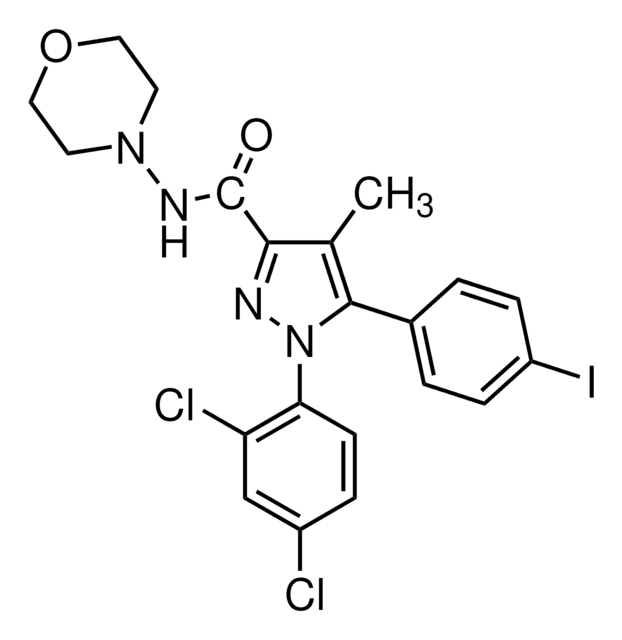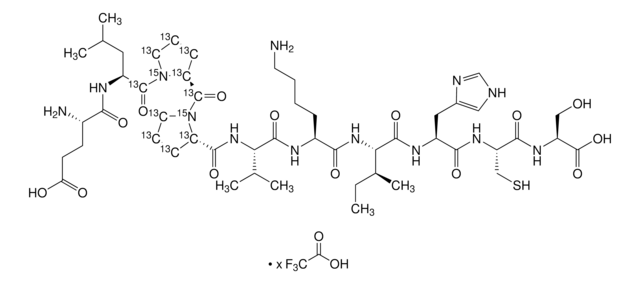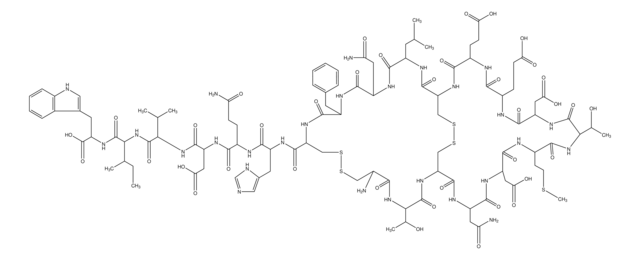おすすめの製品
品質水準
アッセイ
≥98% (HPLC)
形状
powder
色
white to brown
溶解性
DMSO: 2 mg/mL, clear (warmed)
保管温度
2-8°C
SMILES記法
ClC1=CC(Cl)=C(N2C(C3=CC=C(Cl)C=C3)=C(C)C(C(N)=O)=N2)C=C1
生物化学的/生理学的作用
AM4113 is a Cannabinoid CB-1 neutral antagonist. AM4113 reduced reward and reinstatement of drug-seeking behavior, reducing cue-induced reinstatement in monkeys trained to self-administer cocaine.
AM4113 is a pyrazole-3-carboxamide analog of rimonabant (SR141716A). In rats, it suppresses food-motivated behaviors and food intake, thereby reducing weight gain without inducing nausea. AM4113 has poor oral bioavailability. Therefore, it may not act as an effective appetite suppressant in humans.
危険有害性情報
注意書き
危険有害性の分類
Aquatic Chronic 4
保管分類コード
11 - Combustible Solids
WGK
WGK 3
引火点(°F)
Not applicable
引火点(℃)
Not applicable
適用法令
試験研究用途を考慮した関連法令を主に挙げております。化学物質以外については、一部の情報のみ提供しています。 製品を安全かつ合法的に使用することは、使用者の義務です。最新情報により修正される場合があります。WEBの反映には時間を要することがあるため、適宜SDSをご参照ください。
Jan Code
SML1804-25MG:
SML1804-VAR:
SML1804-5MG:
SML1804-BULK:
試験成績書(COA)
製品のロット番号・バッチ番号を入力して、試験成績書(COA) を検索できます。ロット番号・バッチ番号は、製品ラベルに「Lot」または「Batch」に続いて記載されています。
Charles W Schindler et al.
Neuropsychopharmacology : official publication of the American College of Neuropsychopharmacology, 41(9), 2283-2293 (2016-02-19)
Nicotine, the main psychoactive component of tobacco, and (-)-Δ(9)-tetrahydrocannabinol (THC), the main psychoactive ingredient in cannabis, play major roles in tobacco and marijuana dependence as reinforcers of drug-seeking and drug-taking behavior. Drugs that act as inverse agonists of cannabinoid CB1
K S Sink et al.
Pharmacology, biochemistry, and behavior, 91(3), 303-306 (2008-08-16)
Drugs that interfere with cannabinoid CB1 transmission suppress food-motivated behaviors, and may be clinically useful as appetite suppressants. Several CB1 receptor inverse agonists, such as rimonabant and AM251, as well as the CB1 receptor neutral antagonist, AM4113, have been assessed
Sherrica Tai et al.
Psychopharmacology, 232(15), 2751-2761 (2015-03-17)
Previous reports shows rimonabant's inverse properties may be a limiting factor for treating cannabinoid dependence. To overcome this limitation, neutral antagonists were developed, to address mechanisms by which an inverse agonist and neutral antagonist elicit withdrawal. The objective of this
Brian D Kangas et al.
The Journal of pharmacology and experimental therapeutics, 344(3), 561-567 (2013-01-05)
Cannabinoid receptor 1 (CB(1)) inverse agonists (e.g., rimonabant) have been reported to produce adverse effects including nausea, emesis, and anhedonia that limit their clinical applications. Recent laboratory studies suggest that the effects of CB(1) neutral antagonists differ from those of
T U C Järbe et al.
Pharmacology, biochemistry, and behavior, 91(1), 84-90 (2008-07-22)
We examined open-field effects in rats of the cannabinoid 1 receptor (CB1R) agonist WIN55,212-2 (WIN; 3 mg/kg) and its interaction with the CB1R putative neutral antagonist AM4113 (0.3 to 3 mg/kg). Separate studies examined AM4113 alone (0.3 to 5.6 mg/kg).
ライフサイエンス、有機合成、材料科学、クロマトグラフィー、分析など、あらゆる分野の研究に経験のあるメンバーがおります。.
製品に関するお問い合わせはこちら(テクニカルサービス)








